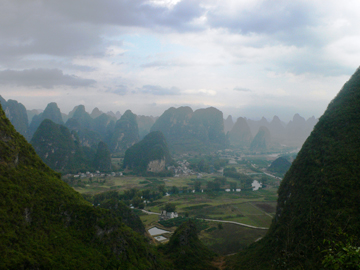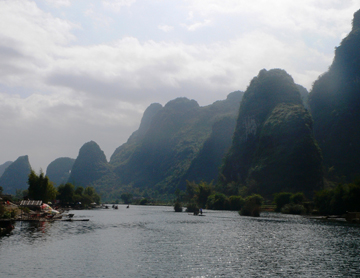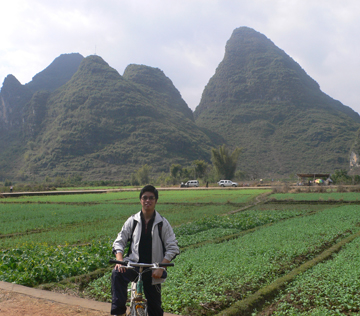|
Travels in Geology April 2007 posted April 20, 2007
Exploring Karst in Guilin, China
 Courtesy of Jordan Clary |
| The view from atop Moon Hill near Guilin, China, gives you a good sense of what the Guilin region is known for — its karst topography. |
On first arriving in Guilin, China, you may feel like you have stumbled into J. R. R. Tolkien's Middle-earth. At any moment you might see Gandalf the Wizard galloping across the plains on his white steed or a dragon roaring down from the sharp cliffs. Guilin, however, is no trick of a novelist's imagination. Its more than 5,180 square kilometers of karst landscape is the result of a perfect alchemy of geological conditions.
Located in the northeast of the Guangxi Zhuang Autonomous Region, Guilin is one of China's leading tourist locations. The Guilin Liangjiang Airport serves approximately 50 domestic and international air routes. Most Western visitors spend a day or two in Shanghai or Hong Kong before coming here, which is only an hour away by plane. Many people prefer, however, to take the train rather than fly. A sleeper car on the train gives ample opportunity to enjoy southern China's landscape at a leisurely pace. A number of bus routes also service Guilin. If you are up for an adventure, road travel in China is something you are likely to remember for a long time. When I rode the bus from Yunnan Province to Guilin, we spent three hours in a rice paddy in the middle of the night surrounded by men in pickup trucks while our driver exchanged some type of "goods" off the top of the bus.
Guilin's most renowned feature is its dramatic karst terrain. Rising sharply at odd angles, limestone peaks look like giant teeth growing out of the green plain. Karst topography is characterized by many caverns and sinkholes that form by the dissolution of limestone or other carbonate rocks. Florida and Virginia's Shenandoah Valley are good examples of where karst can be found in the United States. However, the topography looks completely different from that in China, thanks to conditions that exposed China's karst and eroded its softer limestone faster. The specific conditions for forming the magnificent topography of Guilin "are fourfold," according to Ray Beiersdorfer, a geologist at Youngstown State University in Ohio. "First, you need hard, compact carbonate rock. In Guilin, it's Devonian limestone. Secondly, you need strong uplift, in this case provided by the collision of India with Asia to form the Himalaya. Third, you need a Monsoon climate of high moisture during the warmest season. Finally, the area must not have been scoured by glaciers, which this region wasn't."
Two types of karst landscapes predominate in Guilin: fenglin or peak forest (isolated towers) and fengcong or peak cluster (linked-base towers). The two types may have evolved sequentially from peak forest to peak cluster, or they may have evolved simultaneously. Beiersdorfer described this landscape, which he saw during a recent visit to China: "China in general and the Guilin area specifically boasts some of the most spectacular karst topography in the world."
 Courtesy of Jordan Clary |
| Floating down the Li River near Yangshuo in the Guilin region is like a step back in time. Along the river, women kneel on the banks washing clothes, while farmers follow along behind their water buffalo. |
The area also boasts having signficant archeological finds, such as human teeth and stone tools, that place humans in the Guilin area for the last 30,000 years. A site at Zengpiyan, a cave and local historical monument, has revealed additional cultural artifacts, such as pottery, from the 10th to the 7th millennium B.C. Guilin City proper was first established more than 2,000 years ago during the Qin Dynasty (221 to 206 B.C.) by Emperor Qin Shi Huang, who is best known for creating the army of terra-cotta warriors uncovered in Xian during the 1970s. Emperor Qin Shi Huang is also credited with building the Ling Canal in the Guilin area. The Ling Canal linked the Yangtze and Pearl River systems, thus becoming a significant factor in cultural and economic exchange between central and southern China.
During the Tang Dynasty (A.D. 618 to 907), Guilin thrived.
Huge halls were built and stone walls erected around the city. Today, Guilin
is a rather large, bustling city that attracts visitors from around the world.
The names of the hills surrounding Guilin are poetic: Cloud-Catching Pavilion,
Bright Moon Peak, White Horse Cliff, Five Tigers Catch a Goat Hill, Folded Brocade
Mountain. In fact, as well as a geologist's paradise, this area has long been
an inspiration to countless poets and artists. Many of the traditional Chinese
landscape paintings we see today were inspired by this region.
Most visitors to the Guilin area find a boat trip down the Li River to the town
of Yangshuo to be one of the highlights of their trip. "The river forms
a green gauze belt, the mountains are like jade hairpins," Han Yu, a Tang
Dynasty poet wrote. Drifting down the Li River, it's easy to feel lost in time.
Women kneel on the banks washing clothes. Farmers follow along behind their
water buffalo. Small villages dot the shore. And the boatman will likely point
out animal shapes they see in the surrounding landscape as you float down the
river: horses galloping through the mountainsides, a stone frog leaping into
the water or what looks like a turtle in the sides of a cliff as you float down
the river.
 Courtesy of Jordan Clary |
| Rent a bike and grab a map, or one of the many local guides, and head into Yangshuo for a look at what life in rural southern China is really like. |
The cobblestone Western Street (Xi Jie) in Yangshuo has garnered a reputation as the place in China where East and West really do meet. An abundance of small guest houses and hotels line the street, most of which are quite inexpensive. I've stayed at The Bamboo House several times — one of the few places in China with soft beds. Although its rooms are small, the guest house has charm and the staff is friendly. The Bamboo House has two locations, the newer one being a bit quieter than the old one, which is built over a bar.
Yangshuo's geological offerings can be explored in many ways. Bicycles or electric bikes may be rented to take a riding tour of the countryside. Either buy a map and do it yourself, or hire one of the many local guides who will no doubt approach you on the street. Your guest house will also be happy to recommend a guide.
Black Buddha Cave. Moon Water Cave. Dragon Cave. If it's caving you want, plenty can be found around Yangshuo. Caves and subterranean waters mark this area, and although the caves that can be visited have been domesticated with paved walkways and colored lights, they are, nevertheless, home to some dazzling stalagmites and stalactites. Furthermore, many of the caves are quite large and may include mud baths as part of the admission price. If your interest in rocks tends to be more above ground than below, be sure to bike up to Moon Hill, a mountain with a naturally circular rock window at the top that provides a spectacular panoramic view of the area. A number of shops can also set you up with rock-climbing gear if you want to get a real feel for the craggy landscape.
Although, the Guilin and Yangshuo area can be visited all year, summer offers a few extra pleasures, such as taking a Bamboo Raft on the Yulong (Dragon) River, a tributary of the Li River, or golfing at one of the many golf resorts. And like all places in China, be prepared to bargain for anything you buy, from souvenirs to tour guide fees and bus tickets.
No matter what time of year you go, do your homework first
and plan to spend at least a few days in the region. Celebrations that include
everything from a lantern festival to dragon boat races abound, so be sure to
check to see if one will be occurring while you're there. It's well worth it.
Links:
China
Tourism Web site
Guilin
Tourism
Yangshuo
Travel Guide
Guilan
Travel Guide
Back to top

 Subscribe
Subscribe


